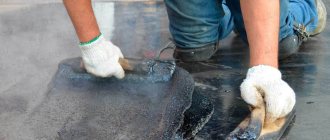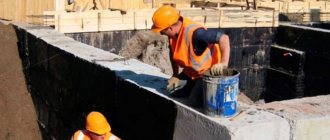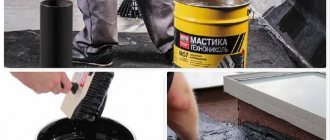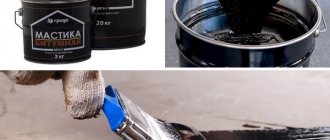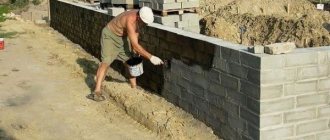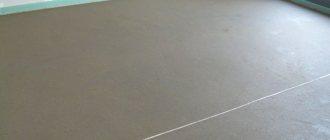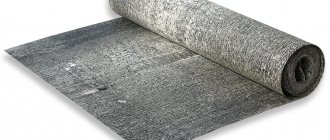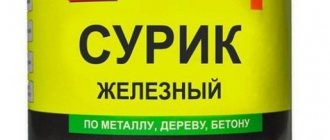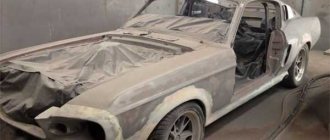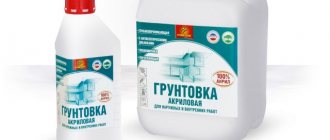At the moment, the most popular material for waterproofing is acrylic waterproofing mastic - an improved product created on the basis of the latest scientific and technical developments.
Waterproofing building structures or building materials involves creating additional protection from the harmful effects and penetration of washing water and moisture, and does not allow the surface covered with waterproofing material to be exposed to undesirable phenomena - mold and mildew. This significantly increases the durability of structures and extends their service life.
Area of application of the material
Not all home owners or builders are familiar with all the features of the coating used. Today the following areas of application of bitumen mastic are known:
- Waterproofing a foundation or pile foundation where seams are not allowed. The special composition of bitumen mastic prevents moisture from penetrating into the foundation. The composition performs similar functions when designing a monolithic roof. A roof finished with mastic will reliably protect its occupants from moisture.
- Using this universal composition, you can carry out repair work on any type of roof.
- Bitumen mastic is used when insulating a house, for example, for attaching polystyrene to the base base.
- Using mastic, you can glue the roofing modules to the selected base. The mastic has excellent adhesion to both roofing felt and classic tiles.
This material is also used for interior decoration of the house, for example, when waterproofing a bathroom, bathtub, or when installing a concrete screed.
Scope of use
Unlike other waterproofing compounds, bitumen-based solutions have no restrictions on use. There are several areas where these compounds are used most often:
- protection against corrosion of floors and other parts of metal structures;
- creating a moisture-proof layer in rooms with difficult operating conditions - in the bathroom, basement, on the balcony;
- waterproofing of floors;
- design of roofs when using rolled or soft materials;
- arrangement of flat roofs;
- processing of the base and foundation.
Advantages of bitumen mastic
Both the roof and the foundation form the basic part of a residential building. In interior decoration, waterproofing of the bathroom and toilet plays a huge role.
Waterproofing concrete screed is especially important when installing heated floors. That is why it is so important to pay maximum attention to the choice of finishing materials.
The advantages of bitumen mastic include the following characteristics:
- Reliability of the material used in the work. Today, manufacturing companies are constantly updating their range of products, lines and materials production technologies, creating new universal formulations.
- Ease of use. Absolutely any home owner can handle any type of mastic.
- This composition can be used if necessary to level walls or floors. Thanks to the addition of various impurities during production, the mastic acquires a characteristic viscosity. The moderately thick consistency allows for optimal application of the composition to any surface.
- The high-quality composition of the bitumen solution prevents the proliferation of any pathogenic microorganisms on the surface of the material.
- The mastic has a high level of adhesion, which allows it to be combined with all types of underlying materials.
- The presence of polymers in the composition of this material prevents the coating from cracking and peeling over time.
- The affordable cost of coverage plays an important role.
With all the obvious advantages, the bitumen composition also has a number of disadvantages. Work with this coating should be postponed until another day if it is raining or there is pronounced fog (with settling of drops of moisture). It is also very difficult to control the amount of material applied, which can lead to increased repair costs.
Properties, technical specifications
Bituminous waterproofing material has its advantages, but at the same time it has some negative qualities. Positive properties:
- Effective protection against precipitation, groundwater, and various types of condensate.
- Resistant to aggressive environments.
- Increased elasticity, which means eliminating the negative influence of large temperature differences and mechanical influences.
- No seams.
- Possibility of application in the cold season.
- Good adhesion.
- Durability.
- Does not require high qualifications.
Waterproofing mastics have a number of negative properties:
- To maintain technical characteristics, polarization is necessary, which takes extra time.
- Hot application requires highly qualified personnel, special equipment, and additional time. There is an increased danger during work.
Specifications:
- Strength of adhesion to the base (adhesion).
- Flexibility on the beam (elasticity).
- Elongation at break.
- Water absorption.
- Waterproof (penetration).
- Softening temperature of dry residue.
- Mass fraction of non-volatile substances.
- Layer thickness.
- Consumption per layer.
- Drying time for one layer.
- Application temperature.
Types of bitumen mastic
Immediately before starting repair work, you should familiarize yourself with the variety of known coatings. Depending on the admixtures used in production, all bitumen compositions are divided into several types:
- Coating with an oil component. Synthetic oils are added to the classic mixture. Such compositions are widely used in the construction and planned repair of sewers, underground treatment facilities, and various communication lines. The presence of synthetic oils dramatically increases the coating's resistance to moisture and vibration. The prevention of cracking is associated with the ability of the mastic to remain in liquid form (the coating does not harden completely).
- Bitumen mastics with rubber crumbs. This composition is used for roof waterproofing. The presence of rubber components allows the mastic to harden very quickly when exposed to air. The universal composition has the most pronounced adhesion, perfectly attaching to any type of surface.
- Modern compositions with polymers (in practice, both natural and artificial polymers are used). Bitumen-polymer mastic has an excellent consistency, is convenient for practical use, and is affordable even for the average person.
There are also bituminous coatings with an admixture of rubber. Don’t forget about the classic composition without additional components.
This coating still does not lose its popularity among construction specialists. Such materials are created on the basis of polyurethane and have pronounced elasticity and tear resistance.
Distinctive features of mastics for facade work
Mastics for facade work differ in two ways:
- According to the base substance.
- Based on readiness for use, mastics are divided into one- and two-component ones. The first ones are sold in their final finished form. When used, they harden as a result of contact with air. Two-component mastics harden after the introduction of vulcanizing agents into them. They are sold as two separate components that must be mixed in specific proportions before use.
Mastics are convenient for repairing facades
Rules for applying bitumen mastic
For successful repair or construction, it is not enough to choose the optimal coating option. For a durable and effective result, you should familiarize yourself with the rules for applying cold bitumen mastic to the underlying surface:
- For a small area, you can use the manual method. For arranging large areas, it is better to give preference to mechanical sprayers. Such devices will allow you to distribute the material used over the surface as evenly as possible.
- The selected area is carefully inspected for damage. Also at this stage, the old coating and remnants of finishing materials should be removed.
- All dust and debris are carefully removed from the future foundation.
- Large cracks and recesses are treated with any adhesive.
- After the adhesive base has completely dried, a primer is applied to the selected area, which must be selected together with bitumen mastic.
Only after the previous layer has completely dried can you begin to cover the base with mastic. The applied strips should overlap each other, and the amount of overlap is about 50 mm.
Today, hot mastic is also known, to work with which you will need a membrane, a sharp knife, and tape with fabric inserts. In this case, the hot composition is applied twice: before laying the membrane and before laying the second membrane.
When working with this composition, you must follow all the rules of caution to prevent injury and burns to tissues.
What is roofing mastic?
To carry out a quick and reliable repair of the roof of a house, you just need to buy a jar or two of a viscous mass - roofing mastic - from a hardware store. This material can be one-component (completely ready for use) or two-component (you will have to mix ingredients from different jars). What is the difference between these mastics?
The one-component mass used to repair the roof of a house is a solvent. When applying mastic to the coating, it evaporates and the material hardens. However, the period of use of the one-component composition is short - only 3 months. Therefore, be extremely careful when purchasing. True, there is a one-component roofing mastic that has a longer shelf life - about 1 year. This is a polyurethane mastic that hardens when moisture evaporates from the mass.
The service life of two-component mastic is also about 1 year.
Photo of bitumen mastic
How to use cold roofing mastic
First of all, you should keep in mind that mastic is still a liquid mass (albeit viscous). This means that if the roof slopes steeply, it will drain (slide). Therefore, as it is in the jar, the mastic is applied to flat areas of the roof or those with a small angle of inclination. If the slope is significant, you need to add a purchased thickener or cement to the mixture, and apply a reinforcing mesh (fiberglass or fiberglass) to the surface in need of repair.
By the way, you can mix dye into the mastic so that the color of the roof covering, after the roof repair is completed, is uniform.
Manufacturing technology of bitumen-polymer mastic
The first step in preparation is loading pure bitumen into a boiler, in which the mass is heated to 140 degrees. During the cooking process in the boiler, the bitumen melts and dehydrogenates. To speed up the process, a defoamer is added. The next step is to pump the molten bitumen into a mixing apparatus, into which KOSZhK and various additives are sequentially added. After adding each component, the solution is thoroughly mixed for 30 minutes. When all the ingredients are mixed, the material is distributed into oil-lubricated metal containers. After complete cooling, the briquettes are treated with talc and packaged in paper packaging.
During the cooking process in the boiler, the bitumen melts and dehydrogenates.
